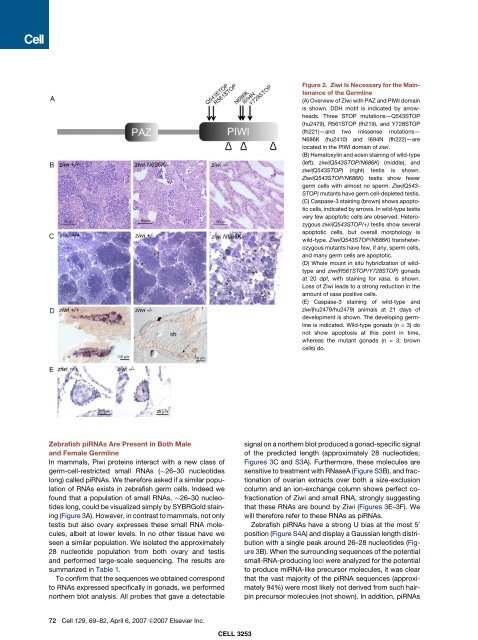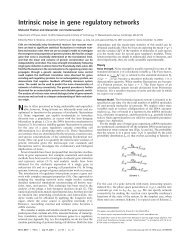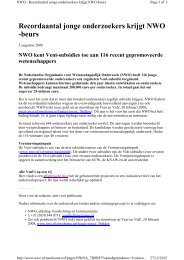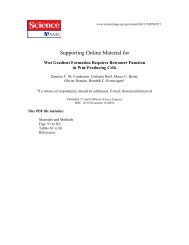A Role for Piwi and piRNAs in Germ Cell ... - Hubrecht Institute
A Role for Piwi and piRNAs in Germ Cell ... - Hubrecht Institute
A Role for Piwi and piRNAs in Germ Cell ... - Hubrecht Institute
Create successful ePaper yourself
Turn your PDF publications into a flip-book with our unique Google optimized e-Paper software.
Zebrafish <strong>piRNAs</strong> Are Present <strong>in</strong> Both Male<br />
<strong>and</strong> Female <strong>Germ</strong>l<strong>in</strong>e<br />
In mammals, <strong>Piwi</strong> prote<strong>in</strong>s <strong>in</strong>teract with a new class of<br />
germ-cell-restricted small RNAs ( 26–30 nucleotides<br />
long) called <strong>piRNAs</strong>. We there<strong>for</strong>e asked if a similar population<br />
of RNAs exists <strong>in</strong> zebrafish germ cells. Indeed we<br />
found that a population of small RNAs, 26–30 nucleotides<br />
long, could be visualized simply by SYBRGold sta<strong>in</strong><strong>in</strong>g<br />
(Figure 3A). However, <strong>in</strong> contrast to mammals, not only<br />
testis but also ovary expresses these small RNA molecules,<br />
albeit at lower levels. In no other tissue have we<br />
seen a similar population. We isolated the approximately<br />
28 nucleotide population from both ovary <strong>and</strong> testis<br />
<strong>and</strong> per<strong>for</strong>med large-scale sequenc<strong>in</strong>g. The results are<br />
summarized <strong>in</strong> Table 1.<br />
To confirm that the sequences we obta<strong>in</strong>ed correspond<br />
to RNAs expressed specifically <strong>in</strong> gonads, we per<strong>for</strong>med<br />
northern blot analysis. All probes that gave a detectable<br />
72 <strong>Cell</strong> 129, 69–82, April 6, 2007 ª2007 Elsevier Inc.<br />
CELL 3253<br />
Figure 2. Ziwi Is Necessary <strong>for</strong> the Ma<strong>in</strong>tenance<br />
of the <strong>Germ</strong>l<strong>in</strong>e<br />
(A) Overview of Ziwi with PAZ <strong>and</strong> PIWI doma<strong>in</strong><br />
is shown. DDH motif is <strong>in</strong>dicated by arrowheads.<br />
Three STOP mutations—Q543STOP<br />
(hu2479), R561STOP (fh219), <strong>and</strong> Y728STOP<br />
(fh221)—<strong>and</strong> two missense mutations—<br />
N686K (hu2410) <strong>and</strong> I694N (fh222)—are<br />
located <strong>in</strong> the PIWI doma<strong>in</strong> of ziwi.<br />
(B) Hematoxyl<strong>in</strong> <strong>and</strong> eos<strong>in</strong> sta<strong>in</strong><strong>in</strong>g of wild-type<br />
(left), ziwi(Q543STOP/N686K) (middle), <strong>and</strong><br />
ziwi(Q543STOP) (right) testis is shown.<br />
Ziwi(Q543STOP/N686K) testis show fewer<br />
germ cells with almost no sperm. Ziwi(Q543-<br />
STOP) mutants have germ cell-depleted testis.<br />
(C) Caspase-3 sta<strong>in</strong><strong>in</strong>g (brown) shows apoptotic<br />
cells, <strong>in</strong>dicated by arrows. In wild-type testis<br />
very few apoptotic cells are observed. Heterozygous<br />
ziwi(Q543STOP/+) testis show several<br />
apoptotic cells, but overall morphology is<br />
wild-type. Ziwi(Q543STOP/N686K) transheterozygous<br />
mutants have few, if any, sperm cells,<br />
<strong>and</strong> many germ cells are apoptotic.<br />
(D) Whole mount <strong>in</strong> situ hybridization of wildtype<br />
<strong>and</strong> ziwi(R561STOP/Y728STOP) gonads<br />
at 20 dpf, with sta<strong>in</strong><strong>in</strong>g <strong>for</strong> vasa, is shown.<br />
Loss of Ziwi leads to a strong reduction <strong>in</strong> the<br />
amount of vasa positive cells.<br />
(E) Caspase-3 sta<strong>in</strong><strong>in</strong>g of wild-type <strong>and</strong><br />
ziwi(hu2479/hu2479) animals at 21 days of<br />
development is shown. The develop<strong>in</strong>g germl<strong>in</strong>e<br />
is <strong>in</strong>dicated. Wild-type gonads (n = 3) do<br />
not show apoptosis at this po<strong>in</strong>t <strong>in</strong> time,<br />
whereas the mutant gonads (n = 3; brown<br />
cells) do.<br />
signal on a northern blot produced a gonad-specific signal<br />
of the predicted length (approximately 28 nucleotides;<br />
Figures 3C <strong>and</strong> S3A). Furthermore, these molecules are<br />
sensitive to treatment with RNaseA (Figure S3B), <strong>and</strong> fractionation<br />
of ovarian extracts over both a size-exclusion<br />
column <strong>and</strong> an ion-exchange column shows perfect cofractionation<br />
of Ziwi <strong>and</strong> small RNA, strongly suggest<strong>in</strong>g<br />
that these RNAs are bound by Ziwi (Figures 3E–3F). We<br />
will there<strong>for</strong>e refer to these RNAs as <strong>piRNAs</strong>.<br />
Zebrafish <strong>piRNAs</strong> have a strong U bias at the most 5 0<br />
position (Figure S4A) <strong>and</strong> display a Gaussian length distribution<br />
with a s<strong>in</strong>gle peak around 26–28 nucleotides (Figure<br />
3B). When the surround<strong>in</strong>g sequences of the potential<br />
small-RNA-produc<strong>in</strong>g loci were analyzed <strong>for</strong> the potential<br />
to produce miRNA-like precursor molecules, it was clear<br />
that the vast majority of the piRNA sequences (approximately<br />
94%) were most likely not derived from such hairp<strong>in</strong><br />
precursor molecules (not shown). In addition, <strong>piRNAs</strong>






